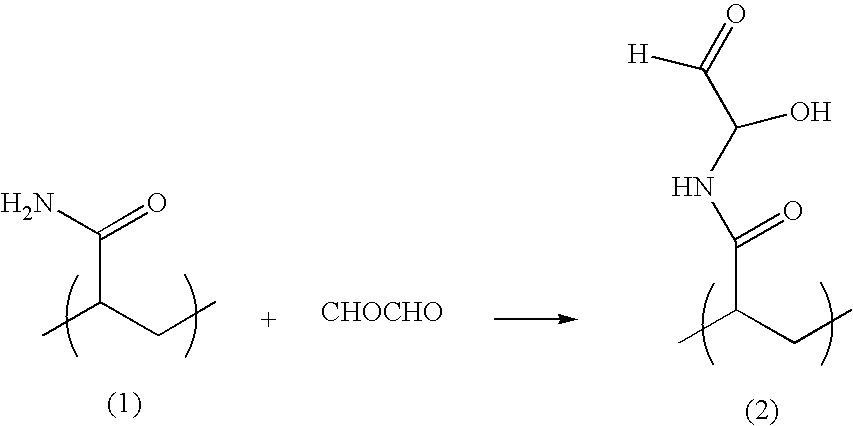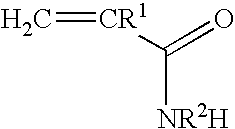Blends of glyoxalated polyacrylamides and paper strengthening agents
a technology of glyoxalated polyacrylamide and paper strengthening agent, which is applied in the field of paper strengthening agent, can solve the problems of poor wet strength, poor paper quality, and rapid loss of strength of paper products made from untreated cellulose fibers
- Summary
- Abstract
- Description
- Claims
- Application Information
AI Technical Summary
Benefits of technology
Problems solved by technology
Method used
Image
Examples
example 1
A Polyamidoamine-Epi Polymer
[0096]To a reaction vessel equipped with an agitator and a reflux condenser was added 218 g of diethylenetriamine. To this was added slowly over 45 minutes 318 grams of solid adipic acid. As the adipic acid was added the reaction temperature climbed steadily from ambient to 140 C, at which point the temperature remained constant. Upon completion of the adipic acid addition, the reaction mixture was then heated to 155° C., at which point reflux began. The reflux condenser was reconfigured for distillation, and water was distilled from the reactor into a collection vessel. During the distillation, the reaction temperature was slowly ramped up to a maximum of 165° C. Distillation was continued at 165° C. until a sample of the reaction mixture, removed from the reactor and diluted to 45% solids, reached a Gardner-Holdt viscosity of L. The distillation condenser was reconfigured for reflux and 350 grams of water was added slowly through the reflux condenser, t...
example 2
Glyoxalated Polyacrylamide Resin
[0098]A suitable 2 liter glass reactor was fitted with a stirring apparatus, thermometer, a nitrogen inlet, a condenser and then placed in heating bath. The reactor was charged with 400 g water, 125 g DADMAC solution (63% concentration), 120 g acrylamide solution (50% concentration), 9 g 2-hydroxyethyl acrylate, 19 g solution of a polyacrylamide-adduct (the adduct of Formula I obtained by reacting 355 g acrylamide 50% solution −2.5 moles—with 51.5 g DETA—0.5 moles—for 30 minutes at 75° C.), having a concentration 56% by weight) and 7 g 2-mercaptoethanol. The reactor was then heated to 80° C. at which time the acrylamide monomer feed (680 g acrylamide (50% concentration), 51 g hydroxyethyl acrylate, 110 g solution of the polyacrylamide-adduct and 41 g 2-mercaptoethanol) and the initiator solution feed (3.2 g ammonium persulfate in 120 g water) were initiated and continuously added to the reactor. The initiator solution flow rate is constant over a tota...
example 3
Composition with 10% of Glyoxalated Polyacrylamide Resin and 90% PAE Resin
[0100]A suitable 1 liter glass beaker was fitted with stirring apparatus. The beaker was charged with 718.6 g of the polyamidoamine-epichlorohydrin (PAE) resin of Example 1 and 100.2 g of the polyacrylamide resin of Example 2. After the addition of the two components, the stirring apparatus turned on immediately. Initial viscosity of mixture was 156 cPs. The mixture temperature did not need to control, just maintained at the room temperature of around 25° C. The two components were maintained to mix at the speed rate of 500 RPM for 30 minutes, resulting in a viscosity increased product. The final mixed product is cationic and water-soluble, has a solids concentration of 24.43 wt. %, cationic charge of 1.89 meq / gram, a pH of 3.0 and a viscosity of 192 cPs at 25° C.
PUM
| Property | Measurement | Unit |
|---|---|---|
| Fraction | aaaaa | aaaaa |
| Percent by mass | aaaaa | aaaaa |
| Percent by mass | aaaaa | aaaaa |
Abstract
Description
Claims
Application Information
 Login to View More
Login to View More - R&D
- Intellectual Property
- Life Sciences
- Materials
- Tech Scout
- Unparalleled Data Quality
- Higher Quality Content
- 60% Fewer Hallucinations
Browse by: Latest US Patents, China's latest patents, Technical Efficacy Thesaurus, Application Domain, Technology Topic, Popular Technical Reports.
© 2025 PatSnap. All rights reserved.Legal|Privacy policy|Modern Slavery Act Transparency Statement|Sitemap|About US| Contact US: help@patsnap.com



